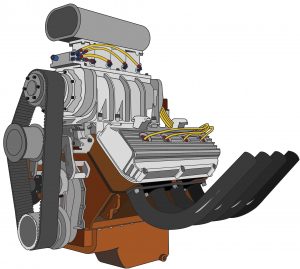
Engine test stands, also called Dyno’s, require precise measurement of various parameters such as pressure, temperature, load and flow. With today’s advanced data acquisition, higher accuracy and faster response sensors are required. Today’s engines operate more efficiently, and many times with higher pressure and temperatures. Choosing the correct pressure sensor for your test stand is critical to meet the EPA or fuel efficiencies requirements.
There are different brands of sensors, and knowing the format and type of pressure sensor to use is critical. Criteria such as pressure formats: gauge, absolute, vacuum, bi-directional, and differential pressure; output type: mV/V, VDC, 4-20 mA, and CAN Bus; as well as the accuracy required, are all criteria that warrant careful consideration.
Gauge Pressure – Gauge sensors are referenced to the atmosphere. This means there is no change in output atmospheric pressure. Gauge sensors can be used to measure positive pressure as well as vacuum.
Absolute Sensors – Absolute sensors reference is full vacuum, or no pressure and the output is zero at full vacuum.
Barometric Sensors – Barometric sensors are basically an absolute sensor with a fixed range. A standard range is 16-32 inch HgA but other ranges around this are available. A 0-30 inch HgA range may also be used but using a more specific range provides more resolution, especially if only small changes in barometric pressure occur.
Vacuum Pressure – Vacuum sensor is set to read zero at atmospheric pressure and the output increases as vacuum increases.
Oil Pressure – To ensure proper lubrication pressure of the engine.
Coolant Pressure – To ensure proper coolant pressure.
Fuel Pressure – To ensure proper fuel pressure.
Cylinder Compression – During a cold test, the engine is mechanical rotated and cylinder pressues are tested.
Leakage – A pressure sensor can be utilized to measure leaks or pressure decay. This can detect bad or missing seals or gaskets as well as other leaking valves and fittings. A DP sensor may also be used (check out our tech note #7 – Selecting a Differential Pressure Transmitter)
Manifold Vacuum – Most vacuum sensors are utilized to measure the intake manifold vacuum.
Two of our core test stand products, the model 240/340 and 241/341, are capable of providing these types of pressure measurement formats.
Our model 240/340 series offers an economical, higher accuracy, compact design that meets the rugged demands of hydraulic and pneumatic pressures found in Dyno’s.
The model 241/341, our most accurate pressure transducer, is designed specifically for automotive test stand applications and incorporates our proprietary digital correction circuit technology to provide high accuracy and high thermal stability. This circuit design provides some of the highest thermal accuracy in its class with an optional compensated temperature range from -40 to +250 ºF (-40 ºC to +125 ºC).
Differential Sensors – A DP sensor has two pressure ports, a high side and low side and provides the difference in pressure between the two ports.
Flow – A differential sensor used across an orifice or Venturi indicates the differential pressure across the orifice/ venturi which can then be equated to a flow measurement. Exhaust, intake air and coolant of fuel flows are areas that require an accurate flow measurement.
Our 2 core DP sensors utilized in engine test stand applications are the model 216/316 and 236/336 series.
The 216/316 is an ultra-low range, high line differential pressure transducer with ranges as low as 0-2.5 inches water column with a min of 500 psi of proof pressure and a 5000 psi line pressure option. It features a compact design and also incorporates our proprietary digital correction circuit technology so as to provide high accuracy and high thermal stability.
The model 236/336 also offers ultra-high accuracy by incorporating our digital correction circuitry in a compact, lower cost design. Ranges as low as 1 psid with line pressure options up to 1000 PSID (69 BAR) are available with accuracy to ±0.05% FSO and high thermal compensation over a -40 to +250 ºF range (-40 ºC to +125 ºC).
Other parameters such as accuracy, output type, electrical connections, process ports, media compatibility, thermal accuracy, and even more can make this selection confusing. With over 35 years of field experience, GP:50 can help you select the most reliable and accurate product to meet your application.
Click on the product links in the diagram below to find out more about these products, and then call our team to find out how GP:50 products can bring more to your automotive test stand application needs.
[devvn_ihotspot id=”8913″]